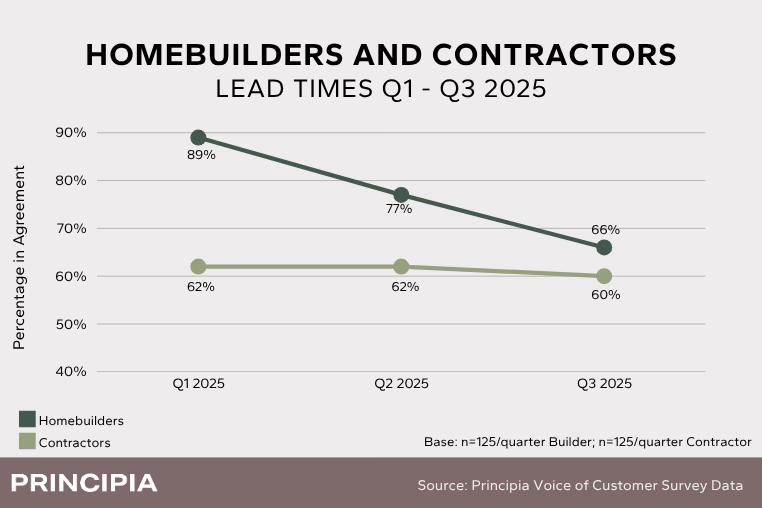Building Product Lead Times: A Mixed View from Homebuilders and Contractors
Principia’s ongoing monthly survey tracks the perceptions of homebuilders and contractors on key business issues. One critical metric—lead times—has a direct impact on project timelines, profitability, and job turnover. Delays in receiving products can stall construction schedules, increase costs, and slow down revenue cycles.
From Q1 to Q3 2025, respondents were asked whether they agreed with the statement: “Lead times from our distributors and/or product suppliers are improving.”
The results reveal a notable divergence between homebuilders and contractors.

Homebuilders show declining confidence.
In Q1 2025, nearly 90% of homebuilders agreed that lead times were improving. By Q3, that number had dropped to 66%—a 23-point decline in just nine months.
Contractor sentiment remains steady.
Unlike homebuilders, contractors have maintained a consistent level of agreement throughout the same period, suggesting more stable experience with product availability.
What Does This Mean for Manufacturers?
While macroeconomic factors like labor shortages, inflation, and global supply chain disruptions certainly play a role, the sharp decline in homebuilder confidence could signal a need for manufacturers to take a closer look at their distribution strategies.
A few strategic areas manufacturers may want to evaluate to help strengthen their market presence and distributor relationships:
Distributor Performance Monitoring
- Regularly assess distributor fulfillment rates, inventory levels, and delivery timelines
- Identify bottlenecks or regional inconsistencies that may be impacting lead times
Transparent Communication Channels
- Ensure timely updates on product availability, delays, and logistic changes
- Consider digital platforms or dashboards that allow builders and contractors to track orders in real time
Demand Forecasting Collaboration
- Work closely with distributors and large customers to align on seasonal demand and project pipelines
- Use predictive analytics to anticipate spikes and adjust production accordingly
Diversified Logistics Strategy
- Explore alternative shipping routes, regional warehousing, or local manufacturing partnerships to reduce dependency on single points of failure
Feedback Loops with End Users
- Use survey data, customer interviews, or field visits to inform product planning and distribution improvements
- Engage directly with homebuilders and contractors to understand pain points and expectations